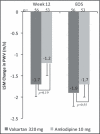Changes in aortic pulse wave velocity in hypertensive postmenopausal women: comparison between a calcium channel blocker vs angiotensin receptor blocker regimen
- PMID: 23126349
- PMCID: PMC8108841
- DOI: 10.1111/jch.12004
Changes in aortic pulse wave velocity in hypertensive postmenopausal women: comparison between a calcium channel blocker vs angiotensin receptor blocker regimen
Abstract
Postmenopausal women are at greater risk for hypertension-related cardiovascular disease. Antihypertensive therapy may help alleviate arterial stiffness that represents a potential modifiable risk factor of hypertension. This randomized controlled study investigated the difference between an angiotensin receptor blocker and a calcium channel blocker in reducing arterial stiffness. Overall, 125 postmenopausal hypertensive women (age, 61.4 ± 6 years; systolic blood pressure/diastolic blood pressure [SBP/DBP], 158 ± 11/92 ± 9 mm Hg) were randomized to valsartan 320 mg ± hydrochlorothiazide (HCTZ) (n = 63) or amlodipine 10 mg ± HCTZ (n = 62). The primary outcome was carotid-to-femoral pulse wave velocity (PWV) changes after 38 weeks of treatment. Both treatments lowered peripheral blood pressure (BP) (-22.9/-10.9 mm Hg for valsartan and -25.2/-11.7 mm Hg for amlodipine, P = not significant) and central BP (-15.7/-7.6 mm Hg for valsartan and -19.2/-10.3 mm Hg for amlodipine, P<.05 for central DBP). Both treatments similarly reduced the carotid-femoral PWV (-1.9 vs -1.7 m/s; P = not significant). Amlodipine was associated with a higher incidence of peripheral edema compared with the valsartan group (77% vs 14%, P<.001). BP lowering in postmenopausal women led to a reduction in arterial stiffness as assessed by PWV measurement. Both regimens reduced PWV to a similar degree after 38 weeks of treatment despite differences in central BP lowering, suggesting that the effect of valsartan on PWV is mediated through nonhemodynamic effects.
© 2012 Wiley Periodicals, Inc.
Figures
References
-
- Atsma F, Bartelink ML, Grobbee DE, van der Schouw YT. Postmenopausal status and early menopause as independent risk factors for cardiovascular disease: a meta‐analysis. Menopause. 2006;13:265–279. - PubMed
-
- Van der Schouw YT, van der Graaf Y, Steyerberg EW, et al. Age at menopause as a risk factor for cardiovascular mortality. Lancet. 1996;347:714–718. - PubMed
-
- Ong KL, Cheung BM, Man YB, et al. Prevalence, awareness, treatment, and control of hypertension among United States adults 1999–2004. Hypertension. 2007;49:69–75. - PubMed
-
- Os I, Oparil S, Gerdts E, Høieggen A. Essential hypertension in women. Blood Press. 2004;13:272–278. - PubMed
-
- Waddell TK, Dart AM, Gatzka CD, et al. Women exhibit a greater age‐related increase in proximal aortic stiffness than men. J Hypertens. 2001;19:2205–2212. - PubMed
Publication types
MeSH terms
Substances
LinkOut - more resources
Full Text Sources
Medical



